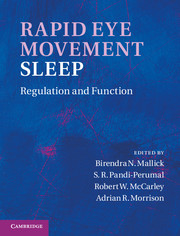Book contents
- Frontmatter
- Contents
- Contributors
- Preface
- Acknowledgments
- Organization
- Section I Historical context
- Section II General biology
- 6 The ontogeny and function(s) of REM sleep
- 7 Evolutionary perspectives on the function of REM sleep
- 8 A systems-level approach to human REM sleep
- 9 REM-sleep regulation: circadian, homeostatic, and non-REM sleep-dependent determinants
- Section III Neuronal regulation
- Section IV Neuroanatomy and neurochemistry
- Section V Functional significance
- Section VI Disturbance in the REM sleep-generating mechanism
- Index
- Plate section
- References
7 - Evolutionary perspectives on the function of REM sleep
from Section II - General biology
Published online by Cambridge University Press: 07 September 2011
- Frontmatter
- Contents
- Contributors
- Preface
- Acknowledgments
- Organization
- Section I Historical context
- Section II General biology
- 6 The ontogeny and function(s) of REM sleep
- 7 Evolutionary perspectives on the function of REM sleep
- 8 A systems-level approach to human REM sleep
- 9 REM-sleep regulation: circadian, homeostatic, and non-REM sleep-dependent determinants
- Section III Neuronal regulation
- Section IV Neuroanatomy and neurochemistry
- Section V Functional significance
- Section VI Disturbance in the REM sleep-generating mechanism
- Index
- Plate section
- References
Summary
Summary
In most mammals, sleep is composed of two distinct states, rapid eye movement (REM) sleep and slow-wave sleep (SWS). The differentiated nature of mammalian sleep suggests that each state performs a different function, or perhaps different, but complementary components of a unified function. Despite extensive research, the function(s) provided by sleep and its respective sub-states remains the subject of debate (Cirelli and Tononi, 2008; Mignot, 2008; Siegel, 2009; Stickgold and Walker, 2007). One approach to unraveling the function of each sleep state is to trace its evolution. Through identifying the type(s) of animals in which each state evolved, we may reveal biological traits that coevolved with a particular sleep state. Cases of convergent evolution may be particularly informative because they provide the opportunity to isolate traits shared by only those animals that evolved a particular sleep state. The independent coevolution of certain sleep states and traits may be functionally linked. Conversely, the subsequent coevolutionary loss of a particular sleep state and certain traits may also reveal traits that benefit from a particular sleep state. Moreover, assuming that sleep serves an important function, determining how such animals compensate for the loss of a particular sleep state may yield clues to its purpose. Finally, another approach is to identify biological traits that account for the variation in time spent in, and presumably need for, each state. Traits that influence the allocation of time to a particular state may suggest a function for that state. The following chapter summarizes insights into the function of REM sleep gleaned from these comparative approaches.
- Type
- Chapter
- Information
- Rapid Eye Movement SleepRegulation and Function, pp. 58 - 70Publisher: Cambridge University PressPrint publication year: 2011
References
- 2
- Cited by



